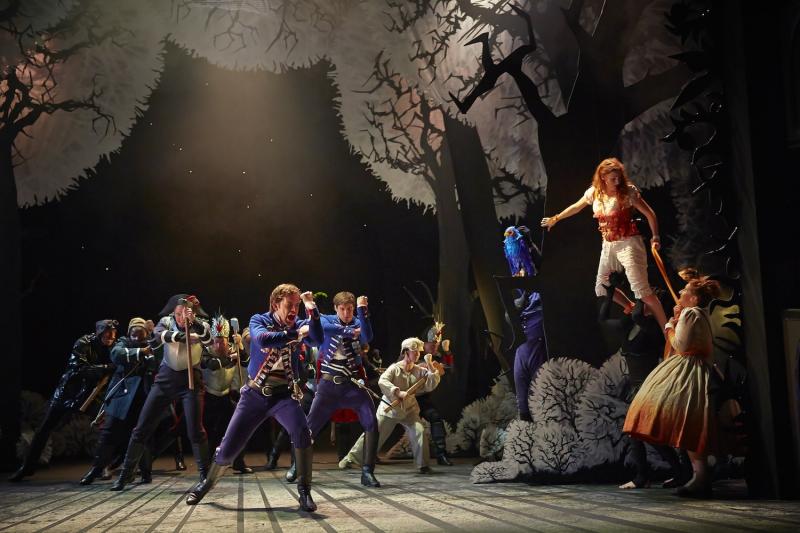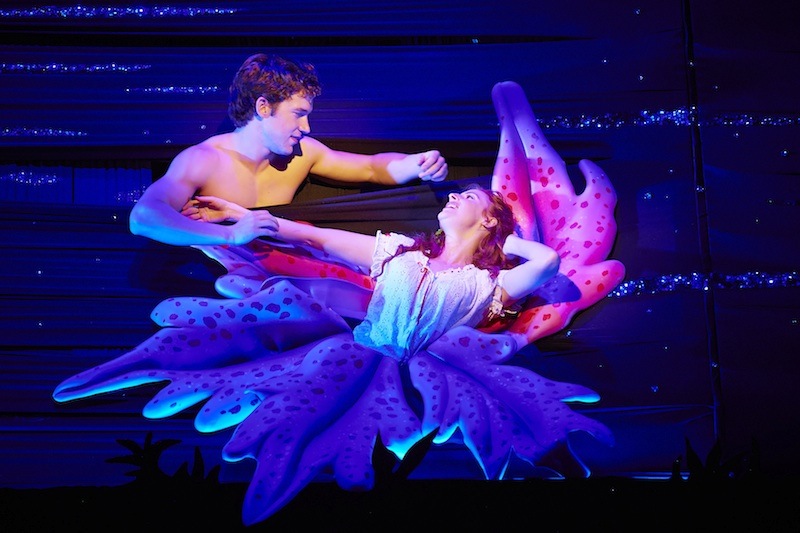The Light Princess, National Theatre | reviews, news & interviews
The Light Princess, National Theatre
The Light Princess, National Theatre
Will this take off? A fairytale musical rustled up by fêted songwriter Tori Amos and playwright Samuel Adamson

Once upon a time, there were two cultures, and they were at odds. A forested wilderness stretches between the kingdoms of Sealand and Lagobel, as we glean from the childishly-drawn, giant map that serves as a front cloth for the NT's new musical spectacular – directed by Marianne Elliot and opening in the Lyttelton last night. The map shows, on one side of the wilderness, Sealand’s coastal realm with winding rivers and a chateau bristling with turrets, all in shades of blue.
Co-written by Tori Amos (on music and lyrics) and the playwright Samuel Adamson (book and lyrics), The Light Princess is loosely based on the Victorian story of the same name penned by George MacDonald. The titular heroine, Rosalie Craig’s Althea, is the adolescent daughter of Lagobel’s King Darius. Her mother died when she was little, at which she remained dry-eyed, determined to rise above grief. Also, her father (played by Clive Rowe) has long ignored her, prizing only his male heir. As a result, she has taken to surreally bobbing around in mid-air like a balloon, insisting on levity.
This pantomime-influenced production is trying to appeal to everyone across different classes and age groups
Holed up in a chamber lined with storybooks, Craig’s reclusive Althea floats aloft. It’s a delightful trompe l’oeil as she appears to waft around weightlessly, in her bloomers, with languid limbs and auburn tresses. She is, in fact, being kept in suspension by a clutch of strongmen who are hooked on to the bookshelves halfway up and dressed in black, so they’re virtually invisible. This is a novel kind of hand-held, human puppetry presented by Elliott who previously, of course, co-directed War Horse.
Later, Althea flees her father’s regime. She meets Nick Hendrix’s Digby, the Prince of Sealand, in the forest, where he’s on the march with an invading army. Meant to be gravity personified, he is heavy-hearted due to his mother’s death. Yet Althea makes him smile. The scene where they fall for each other – or rather rise and fall for each other – exquisitely uses aerial acrobatics to express amorousness (with movement direction by Steven Hoggett). Craig is hovering overhead, now wire-flying but tethered to Hendrix by a silk ribbon. Whilst intending to keep her distance, she keeps being softly drawn down to him in a kind of courtship dance that, in turn, lifts him off the ground.
Alas, other elements of this production fall disappointingly flat. Overall, there’s more stylized choreography than real sexual chemistry or characterization. As for Amos’ contribution, her track record as a Grammy-nominated singer/songwriter – particularly her folk-influenced hit single “A Sorta Fairytale” – inspired high hopes.
However, the songs punctuating The Light Princess (orchestrated by Amos and Martin Lowe in conjunction with John Philip Shenale) sound plodding, schmaltzy and sub-Lloyd Webber in the main. They’re not strikingly original, only occasionally rousing.
 Rosalie Craig's Althea reclines on a water lilly, in the swim with Nick Hendrix's Digby
Rosalie Craig's Althea reclines on a water lilly, in the swim with Nick Hendrix's Digby
The lyrics surely aren’t going to be winning any awards, rhyming “See my tears flow” with “H20” when Althea learns to feel deeply. The storyline is scrambled too, even after premiere-delaying rewrites. What Althea’s floating represents is interestingly complex (mirthfulness, political irresponsibility, spirited independence). Nonetheless, an attempt to embrace other readings (including drugs and anorexia) is clumsily managed.
Visually, Elliott’s multimedia team of designers are also hit and miss. I suspect this pantomime-influenced production is trying to appeal to everyone, across different classes and age groups. The set and costumes veer none too winningly, though, between the classy and the tacky. The forest is spookily beautiful, with moonlit trees like jagged coral, except the lake into which Althea and Digby plunge could hail from a Las Vegas cabaret devised by Barbie. It’s covered with cheap glitter and lurid pink water lilies – or were they splashes of exotic vomit?
I suppose my aesthetic complaints might be countered by the story’s final message: a plea for cultural divisions to be surmounted. However, the ecological credo that’s attached to that conclusion – saying we must protect the natural environment – might have carried more weight if that pond had been prettier.
- The Light Princess at the National Theatre to 9 January
Follow Kate Bassett on Twitter
Overleaf: watch Tori Amos's video for "A Sorta Fairytale"
rating
Explore topics
Share this article
Add comment
The future of Arts Journalism
You can stop theartsdesk.com closing!
We urgently need financing to survive. Our fundraising drive has thus far raised £49,000 but we need to reach £100,000 or we will be forced to close. Please contribute here: https://gofund.me/c3f6033d
And if you can forward this information to anyone who might assist, we’d be grateful.

Subscribe to theartsdesk.com
Thank you for continuing to read our work on theartsdesk.com. For unlimited access to every article in its entirety, including our archive of more than 15,000 pieces, we're asking for £5 per month or £40 per year. We feel it's a very good deal, and hope you do too.
To take a subscription now simply click here.
And if you're looking for that extra gift for a friend or family member, why not treat them to a theartsdesk.com gift subscription?
more Theatre
 Troilus and Cressida, Globe Theatre review - a 'problem play' with added problems
Raucous and carnivalesque, but also ugly and incomprehensible
Troilus and Cressida, Globe Theatre review - a 'problem play' with added problems
Raucous and carnivalesque, but also ugly and incomprehensible
 Clarkston, Trafalgar Theatre review - two lads on a road to nowhere
Netflix star, Joe Locke, is the selling point of a production that needs one
Clarkston, Trafalgar Theatre review - two lads on a road to nowhere
Netflix star, Joe Locke, is the selling point of a production that needs one
 Ghost Stories, Peacock Theatre review - spirited staging but short on scares
Impressive spectacle saves an ageing show in an unsuitable venue
Ghost Stories, Peacock Theatre review - spirited staging but short on scares
Impressive spectacle saves an ageing show in an unsuitable venue
 Hamlet, National Theatre review - turning tragedy to comedy is no joke
Hiran Abeyeskera’s childlike prince falls flat in a mixed production
Hamlet, National Theatre review - turning tragedy to comedy is no joke
Hiran Abeyeskera’s childlike prince falls flat in a mixed production
 Rohtko, Barbican review - postmodern meditation on fake and authentic art is less than the sum of its parts
Łukasz Twarkowski's production dazzles without illuminating
Rohtko, Barbican review - postmodern meditation on fake and authentic art is less than the sum of its parts
Łukasz Twarkowski's production dazzles without illuminating
 Lee, Park Theatre review - Lee Krasner looks back on her life as an artist
Informative and interesting, the play's format limits its potential
Lee, Park Theatre review - Lee Krasner looks back on her life as an artist
Informative and interesting, the play's format limits its potential
 Measure for Measure, RSC, Stratford review - 'problem play' has no problem with relevance
Shakespeare, in this adaptation, is at his most perceptive
Measure for Measure, RSC, Stratford review - 'problem play' has no problem with relevance
Shakespeare, in this adaptation, is at his most perceptive
 The Importance of Being Earnest, Noël Coward Theatre review - dazzling and delightful queer fest
West End transfer of National Theatre hit stars Stephen Fry and Olly Alexander
The Importance of Being Earnest, Noël Coward Theatre review - dazzling and delightful queer fest
West End transfer of National Theatre hit stars Stephen Fry and Olly Alexander
 Get Down Tonight, Charing Cross Theatre review - glitz and hits from the 70s
If you love the songs of KC and the Sunshine Band, Please Do Go!
Get Down Tonight, Charing Cross Theatre review - glitz and hits from the 70s
If you love the songs of KC and the Sunshine Band, Please Do Go!
 Punch, Apollo Theatre review - powerful play about the strength of redemption
James Graham's play transfixes the audience at every stage
Punch, Apollo Theatre review - powerful play about the strength of redemption
James Graham's play transfixes the audience at every stage
 The Billionaire Inside Your Head, Hampstead Theatre review - a map of a man with OCD
Will Lord's promising debut burdens a fine cast with too much dialogue
The Billionaire Inside Your Head, Hampstead Theatre review - a map of a man with OCD
Will Lord's promising debut burdens a fine cast with too much dialogue

Comments
Is this a review or a
Criticising a production for
When it comes to music
some of the worst music- and
Perhaps you need training in